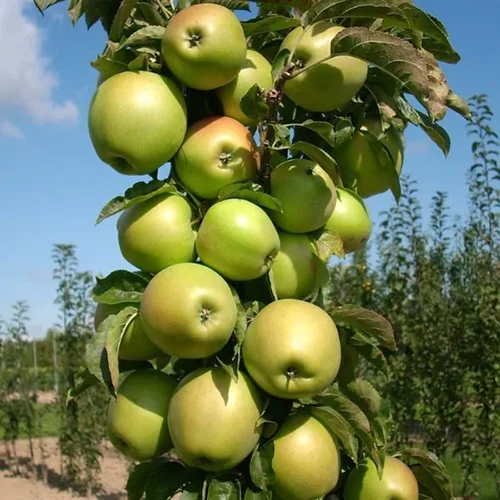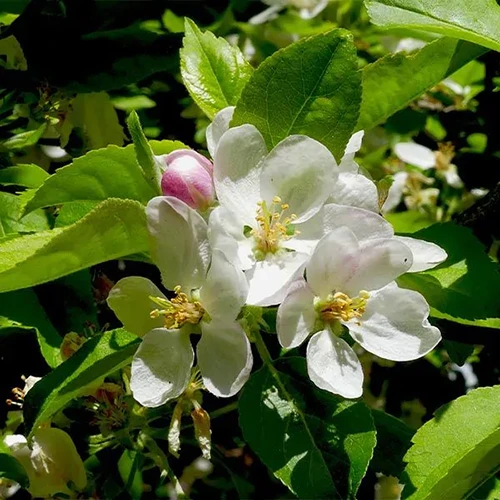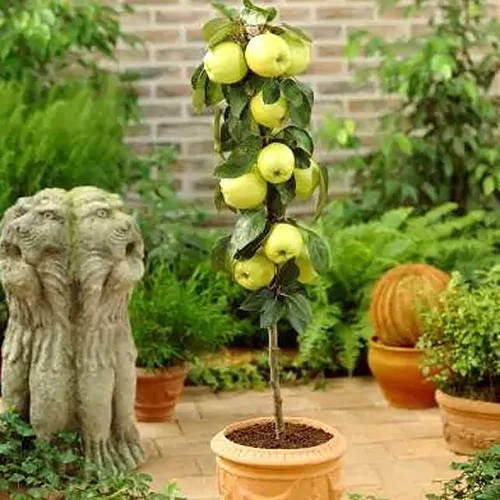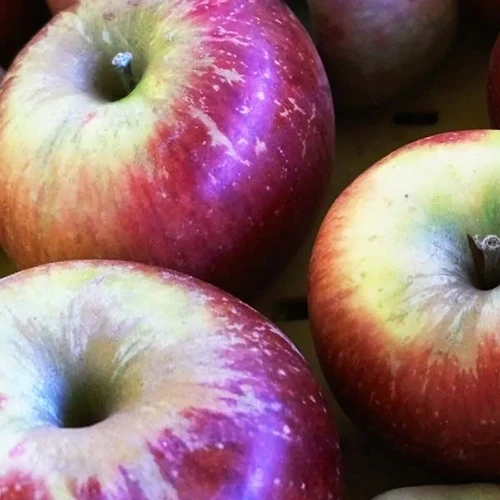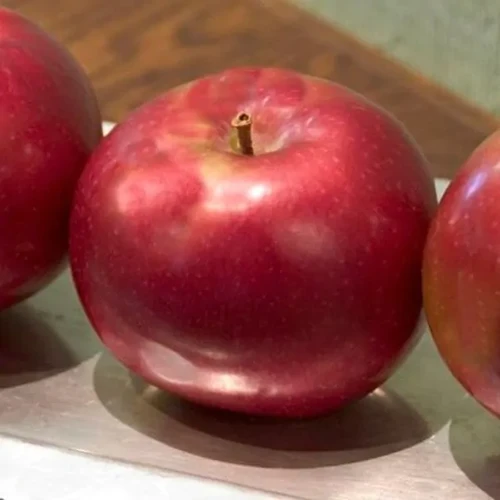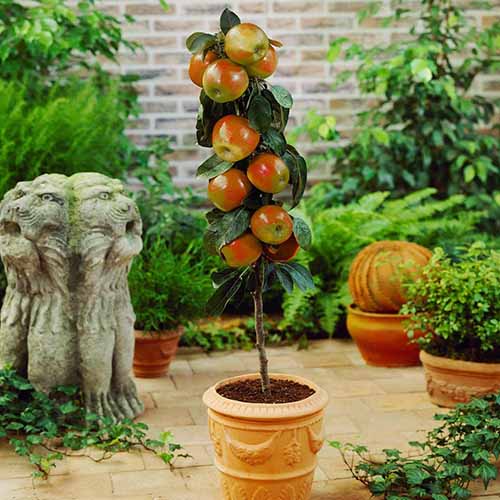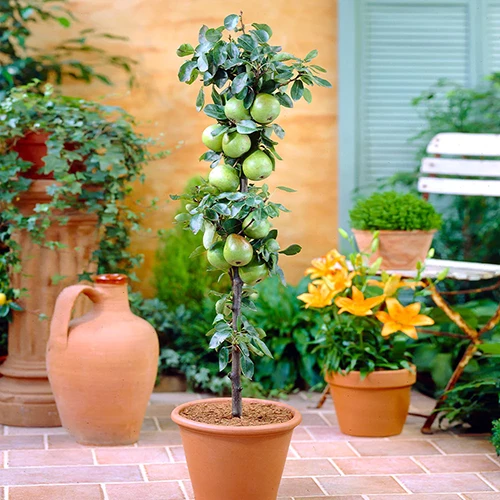We aren’t all blessed with acres and acres of land.
Most of us have to make do with a small patch of soil, or sometimes without any land at all. But apple tree lovers shouldn’t give up on their orchard dreams.
We just need to figure out how to make do with less space.

We link to vendors to help you find relevant products. If you buy from one of our links, we may earn a commission.
There are so many fantastic dwarf apples out there that hardly take up any space at all.
There are even a few that don’t branch out, so you only need a few square feet to grow and harvest your own fruits.
Heck, if you want to, you can even grow apple trees as bonsai. They produce full-sized fruit!
Need a quick refresher on growing your own apples? Start here.
If you’re dreaming of apples but you don’t have a lot of space, keep reading. We’re going to check out some of the best dwarf apple tree options out there.
Here’s a quick preview of what’s coming up:
13 of the Best Dwarf Apple Trees
Apples come in three sizes: standard, semi-dwarf, and dwarf.
Standards reach about 30 feet tall, semi-dwarf cultivars grow to heights of 14 to 22 feet, and dwarf varieties stay under about 12 feet tall.
Most dwarf and semi-dwarf trees are propagated using grafted rootstock.
That’s part of why these trees won’t grow true from seed. If you were to plant a seed that came from an fruit produced by one of these trees, you’d end up with a full-sized tree that would be nothing like the parent.

There are a few “true” dwarf trees. These are cultivars that have been bred over years to stay small rather than being grafted onto rootstock.
These wouldn’t grow true from seed either, since apple seeds are produced via pollination, a form of sexual reproduction that combines the DNA of the parent plants. Grafted trees, on the other hand, are clones of the parent with identical DNA.
Most dwarf trees require staking because they aren’t strong enough to stay upright when they have a full load of fruit. They have smaller root systems that will topple right out of the ground in high wind or heavy rain.
Be sure to read our guide to pollinating apple trees if you aren’t already familiar with the requirements. Most apples need to be planted with another apple or crabapple tree that blooms around the same time nearby in order to produce a harvest.
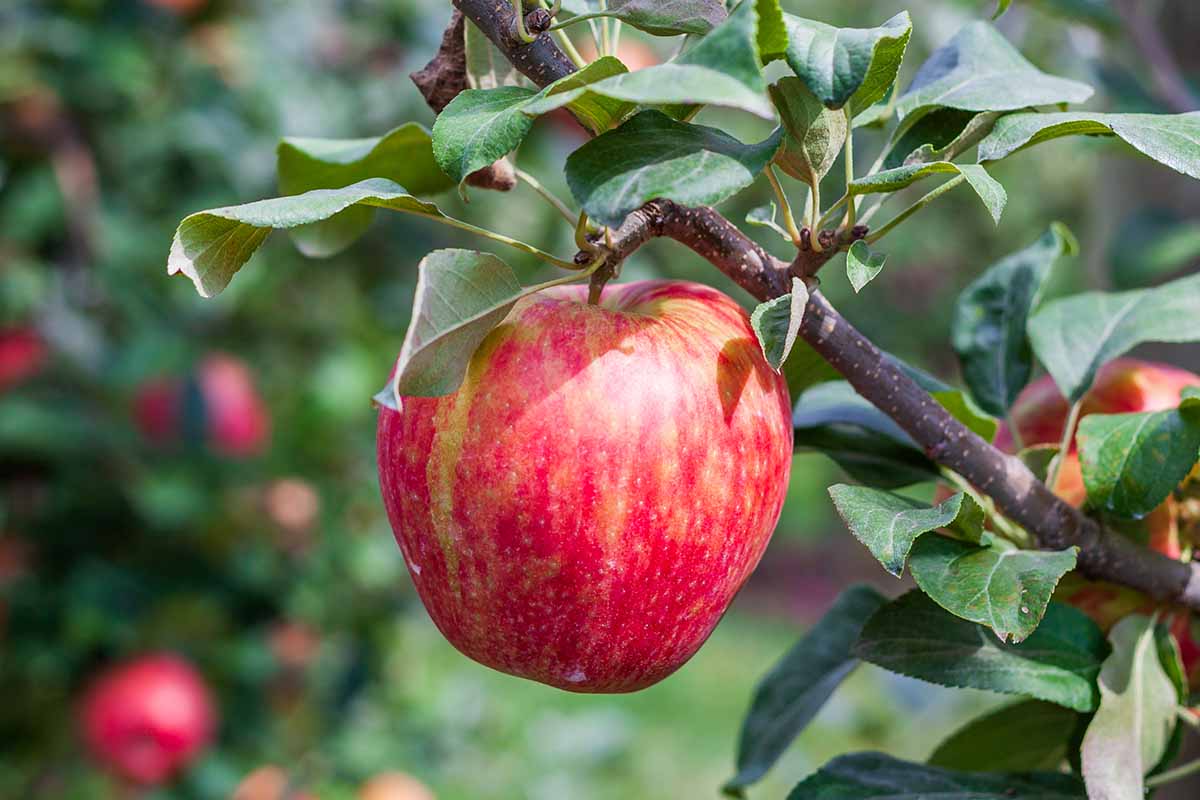
Also, keep chill hours in mind. Apple trees need a certain number of hours per year under 45°F and above 32°F to produce fruit.
This isn’t related to how hot your climate is overall. For instance, I live in the Pacific Northwest, where our temperatures are usually moderate. We rarely see freezing weather, but we log about 3,000 chill hours each year.
Meanwhile, the notoriously cold winters of North Dakota don’t translate to a lot of chill hours – again, these are chill hours, not hours spent below freezing. They only receive 800 chill hours in Bismarck.
People in southern Florida and Texas don’t have any chill hours to speak of, for the most part, which is great if you hate sweaters but bad if you want to grow this type of fruit.
Most apples are hardy in Zones 4 to 8, but we’ll let you know if one of our selections below deviates from this.
1. Ambrosia
If the name of this cultivar has you dreaming about honey-sweet fruits, you’re on the right track. The fruits are sweet and floral.

I usually prefer a tart apple, but if you’re going to offer me an ‘Ambrosia,’ I could never pass it up. It’s like a sweet fig wrapped in crisp yellow and red skin. There are absolutely no tart notes in this apple.
‘Ambrosia’ was randomly discovered by Sally and Wilfrid Mennell in British Columbia, Canada, where their orchard is located. It quickly became a Canadian favorite.
Since they lack acid, they don’t brown as quickly as other apples. They also have a thin skin, so there’s no need to peel them. In Zones 4 to 8, this plant will top out at 12 feet.
Make sure you plant it somewhere that will receive 600 chill hours and give this group 4 pollinator a group 3, 4, or 5 friend.
2. Blushing Delight
Part of the Urban Apples® brand, Blushing Delight™ is a columnar (or limbless) dwarf apple that stays a slim two feet wide and 10 feet tall.
It doesn’t need support, but you can grow it next to a wall or column to save space.
The yellow fruits take on a pretty blush hue when they’re ripe, which happens in mid-September.
This disease-resistant cultivar is a mid-season bloomer, so find it a companion that blooms at the same time. Anything in group 2, 3, or 4 will work, and it needs 800 chill hours.
It’s available at Nature Hills as a bare root if you need something that won’t eat up all the extra room in your garden.
Or you can grab a pair of pollinators, with a ‘Blushing Delight’ paired with ‘Golden Treat,’ also at Nature Hills Nursery.
3. Garden Delicious
Nope, not ‘Golden Delicious.’ Dwarf ‘Garden Delicious’ is self-fruitful, so it doesn’t need a companion if you don’t want to provide one.
If you do give it a pollinating pal, it will provide even more of the perfectly balanced sweet-tart chartreuse fruits.
FYI: This is an early-season bloomer (group 1), and you’ll need to select another early or early to midseason bloomer to plant nearby (group 1 or 2).
Another standout characteristic is that this tree only needs 600 chill hours, so it’s perfect for warmer regions.
Resistant to apple scab and hardy in Zones 4 to 9, Nature Hills carries ‘Garden Delicious’ as a three- to four-foot-tall plant in a #3 container.
At that size, you could very well be eating your own homegrown apples the same year you plant.
4. Golden Sentinel
‘Golden Sentinel’ gives you gorgeous golden yellow and blush red apples late in the season, ripening over a few weeks in October in most areas.
This tiny tree is a columnar type, which means it doesn’t branch out, and it produces fruits on the main trunk.
It only grows 10 feet tall and three feet wide, which means you can put it just about anywhere so long as it has full sun.
‘Golden Sentinel’ needs 800 chill hours and a pollinator friend that blooms at midseason, or to mid to late season (groups 4 or 5).
It’s so pretty that you could grow it as an ornamental, with the fruits being a major bonus. Visit Nature Hills Nursery to nab one.
5. Honeycrisp
Most of us have nibbled on a Honeycrisp™ from the store, but you haven’t tried a real Honeycrisp until you’ve had one fresh off the tree.
You can find these trees in dwarf, semi-dwarf, and standard sizes, with the dwarf options topping out at 10 feet.
The fruits mature at mid-season in the fall, ready for snacking in mid-September, and it takes several weeks for all of the fruits to mature so you don’t have to eat them all at once.
The blossoms appear at mid-season in spring, so pick a partner that blooms at the same time. Those in group 2, 3, and 4 are good candidates.
This cultivar needs about 800 chill hours to produce.
If you want a ready-made dessert apple with a sweet taste and crisp texture, visit Fast Growing Trees to nab a dwarf tree.
Find tips on caring for Honeycrisp trees here.
6. Leprechaun
‘Leprechaun’ is a true dwarf bred from a ‘Granny Smith.’ It has the same characteristic lime green, crisp-tart fruits but they grow on a tree that stays under six feet tall.
This is another one of the rare dwarf varieties that doesn’t require staking.
Bred in Australia, ‘Leprechaun’ can be hard to find in the US, but specialty retailers carry it.
Once you find yours and bring it home, make sure you give it a companion because it isn’t self-fruitful. This cultivar flowers early in the season.
Give it 800 chill hours in Zones 4 to 9.
7. Melrose
‘Melrose’ is right on the cusp of dwarf and semi-dwarf at 12 to 15 feet tall, but it’s too good to keep off of this list.
Developed at the Ohio Agricultural Experiment Station during World War II, it’s a cross between ‘Jonathan’ and ‘Red Delicious’ that features the best of both. It’s even the official apple of Ohio.
Though it needs 1,000 chill hours and grows in Zones 5 to 9, the harvested fruit keeps well. It has creamy white flesh without being mealy.
They’re tart with just enough sweetness to balance it out, and they have a pleasing flattened shape.
When these apples are available at my local farmers market, they sell out super fast.
I’m not sure if it’s the yellow, green, and red skin that is just begging for an Instagram moment or the flavor. Both make sense to me!
The trees are extremely vigorous and partially self-pollinating. It’s a mid-season harvest and blossom type (group 3), so if you decide to give it a pollinator friend, look for one that blooms at the same time.
You’ll be able to harvest way more fruits if you plant a suitable companion.
Nature Hills has three- to four-foot tall plants in #3 containers available in case you’re feeling the pull of ‘Melrose.’
8. Pixie Crunch
‘Pixie Crunch’ is a petite treat. It stays under 10 feet tall, blooms mid to late season, and it must have a pollinator companion.
Since it’s in group 4, look for a friend to plant nearby from group 3, 4, or 5.
The flesh is crunchy (as you’d expect) and sweet, blending the flavor of its ‘Golden Delicious’ and ‘Red Rome’ parentage. It’s also disease resistant and hardy in Zones 3 to 8.
This cultivar needs about 800 chill hours.
9. Red Prairie Spy
‘Red Prairie Spy’ is grown on semi-dwarf rootstock, but it typically stays about 10 feet tall.
Just be aware that it could potentially reach up to 15 feet, so if a short stature is important, be aware that this one might grow too big for you.
For those who can’t imagine Halloween without delicious red apples, this one is a good choice. The harvest is ready in October, though it takes up to a month for all of the fruits to mature.
The fruits are super juicy and sweet, perfect right off the tree, but they also store well for a long time.
This cultivar was developed for commercial growers in areas with harsh winters.
It’s rated for cold winters to Zone 4, but I know someone in 3b who is enjoying massive harvests each year. It’s one tough cookie, in a petite package!
Dreaming of Thanksgiving apple pies? Pick up a ‘Red Prairie Spy’ at Nature Hills Nursery. They carry four- to five-foot bare roots.
At that size, you can expect fruits the year of or the year after you plant.
10. Scarlet Sentinel
Big, juicy, classic red fruits grow on this three-foot-wide and 10-foot-tall tree, meaning you can have that characteristic scarlet apple sweetness and crunch even if you only have a tiny spot available. This type can even be grown in containers!
This early to mid-season bloomer needs 800 chill hours, but more is better, and up to 1,200 is ideal for the best harvest.
This tree is vigorous, reliable, and disease-resistant. It even tolerates extreme heat, which can spell disaster for some apples.
Want one of your own? Me too. Pick one up at Fast Growing Trees, and grab one for me too.
11. Sweet Sixteen
Plant breeders at the University of Minnesota crossed a ‘Northern Spy’ and ‘Frostbite’ to create ‘Sweet Sixteen’ for growing in areas with frigid winters. It’s hardy in Zones 3 to 8.
‘Sweet Sixteen’ lives up to its name. Plant it with another mid-season bloomer, and you’ll be treated to super sweet fruits in early fall with notes of cherry.
They’re so sweet that you might not need to add sugar to your dessert recipes. But they break down readily, dissolving with prolonged exposure to heat, so they’re best enjoyed fresh or after just a short bake.
This dwarf tree grows to just 10 feet tall, and it also comes in a semi-dwarf size.
The fruit is as pretty as it is delicious, with bright red flesh covered in swipes and patches of yellow. Give this one about 800 chill hours.
12. Tangy Green
Another member of the Urban Apples® brand, Tangy Green™ is a columnar tree that grows just eight to 10 feet tall and two feet wide.
This mid-season bloomer needs a friend, but so long as it has a pollinator, you’ll get more fruits than you’d probably expect.
The fruits are green with a slightly tart flavor. It’s extremely disease resistant, but make sure it gets 800 chill hours, or you won’t be knee-deep in apple pies come late summer.
Plant it in a container or the tiniest of garden spaces. Grab this cultivar at Fast Growing Trees.
13. Tasty Red
A sibling of Tangy Green™ and other Urban Apples® cultivars, Tasty Red™ is a columnar type that grows two feet wide and 10 feet tall.
The bold red apples are as pretty as they are flavorful, with sweet flesh and crisp skin.
Imagine a Tasty Red™ and Tangy Green™, both mid-season bloomers, flanking your patio doorway. It would be so cute!
And you’d be able to enjoy both tangy green and sweet red fruits come late summer, around mid-September.
If you live in Zones 4 to 9, you can make this variety a part of your garden, patio, porch, or tiny balcony. Purchase one now at Nature Hills Nursery.
Good Things Can Come in Tiny Packages
You don’t need a huge yard to grow apples. These trees can come in small packages and they still grow full-sized fruits, just fewer of them.
And let’s be real – most of us can’t use up all the apples produced by a full-sized tree anyway.
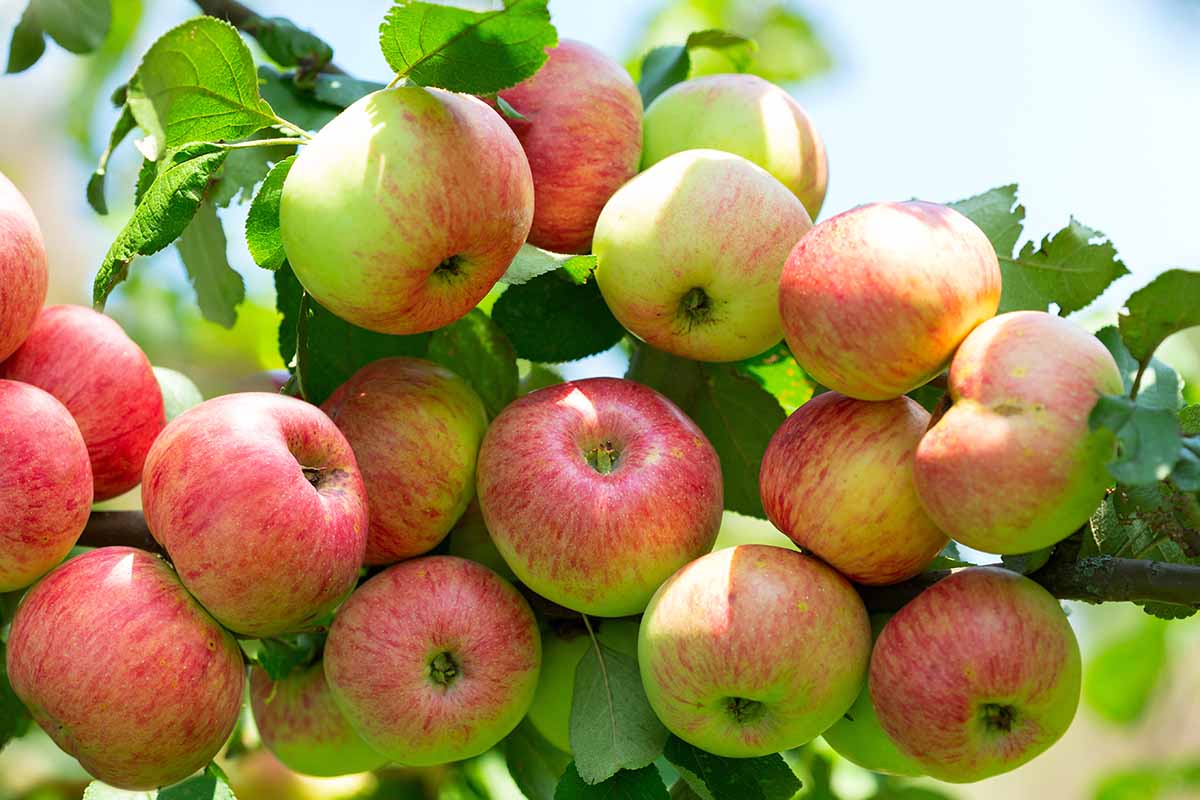
Are any of these options calling your name? Let us know which cultivar appeals to you in the comments below!
Once you get your tree in the ground or into a container, you’ll probably need a bit more info on how to care for and use your apples, right? If so, consider checking these articles out next:
